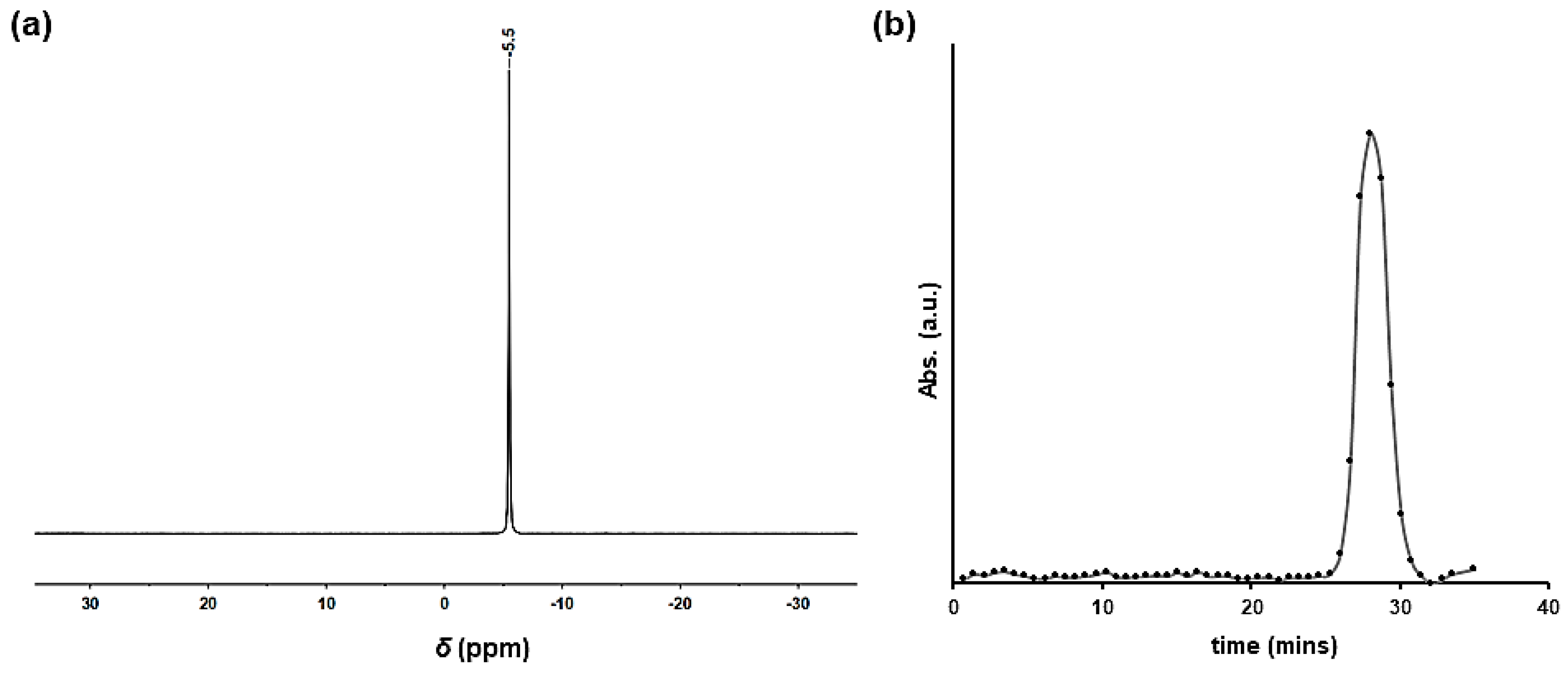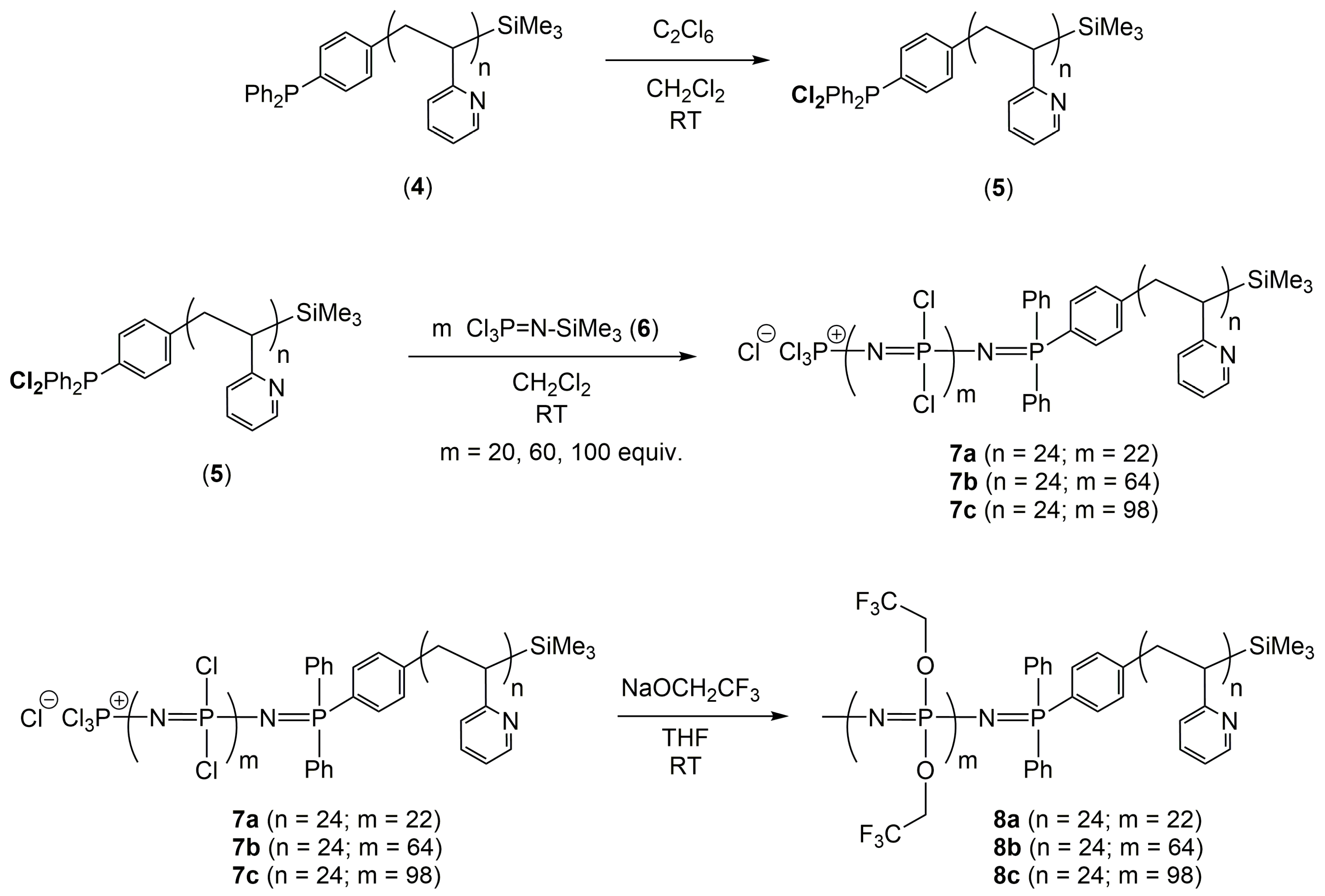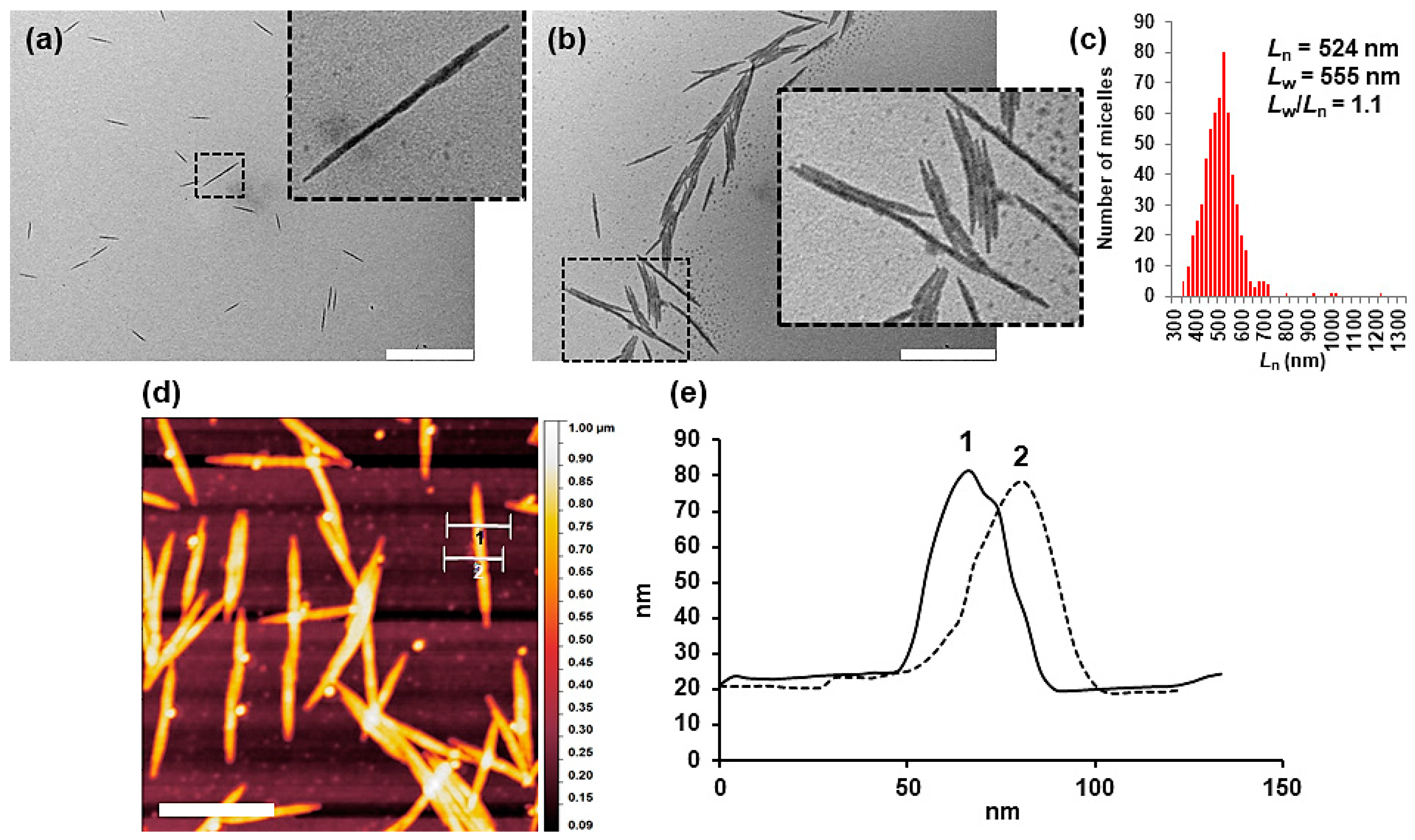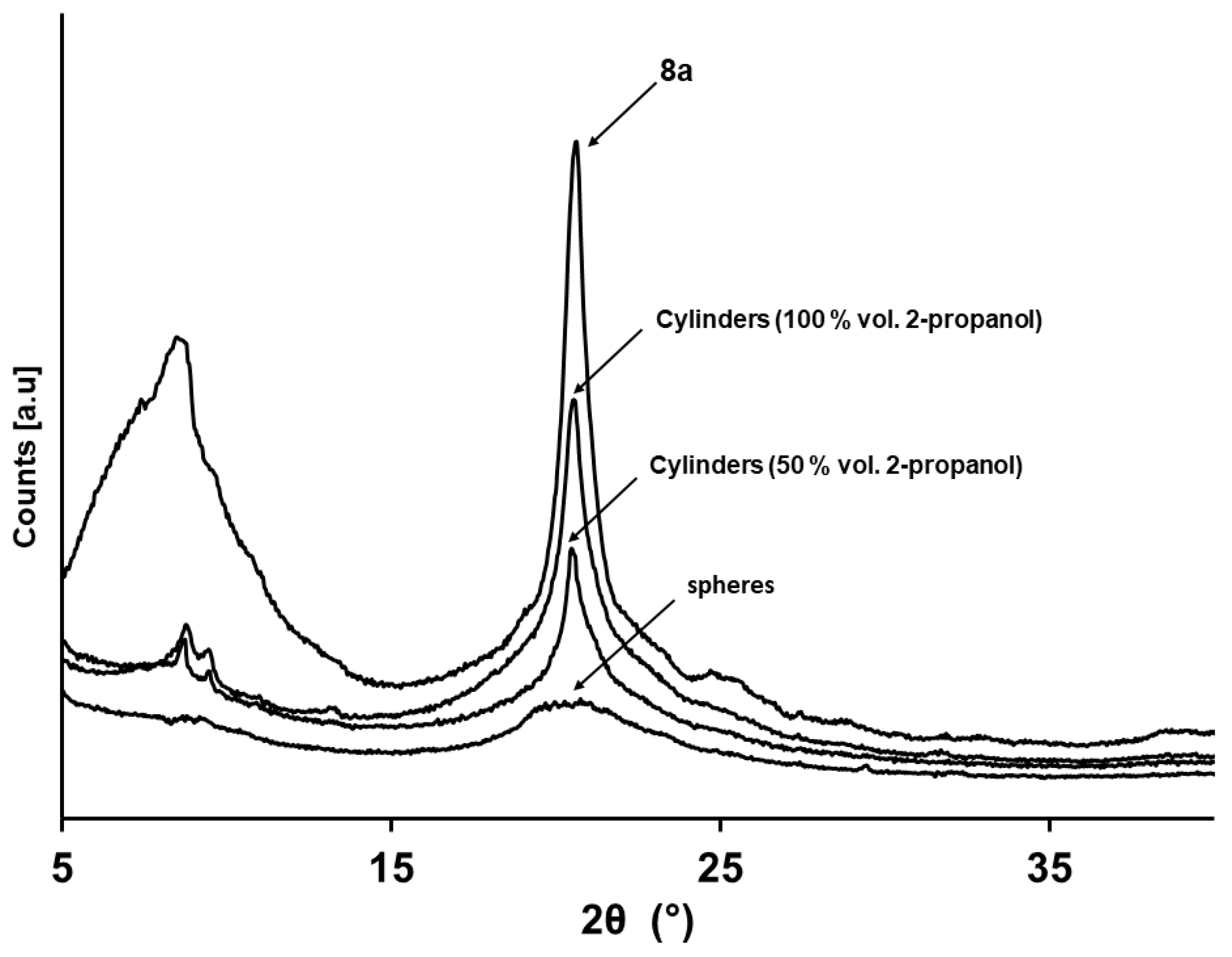Cylindrical Micelles by the Self-Assembly of Crystalline-b-Coil Polyphosphazene-b-P2VP Block Copolymers. Stabilization of Gold Nanoparticles
Abstract
1. Introduction
2. Results and Discussion
2.1. Synthesis of Telechelic Phosphane-Terminated Poly(2-vinylpyridine) (P2VP-PPh2, 4)
2.2. Synthesis of Poly(Bistrifluoroethoxy Phosphazene)-b-poly(2vinylpyridine) (PTFEP-b-P2VP) Block Copolymers 8a–c
2.3. Solution Self-Assembly of PTFEP-b-P2VP Block Copolymers 8a–c
2.4. Crystallization of PTFEP Block at the Core of the Micelles During the Solution Self-Assembly of PTFEP-b-P2VP Block Copolymer 8a
2.5. Gold Nanoparticles (AuNPs) Decorated Nanocylinders
3. Conclusions
4. Experimental Part
4.1. Materials
4.2. Methods
4.2.1. Synthesis of the Telechelic P2VP24-PPh2 (4)
4.2.2. Synthesis of Block Copolymers PTFEP-b-P2VP (8a–c)
Supplementary Materials
Author Contributions
Funding
Conflicts of Interest
References
- Lazzari, M.; Liu, G.; Lecommandoux, S. Block Copolymers in Nanocience; Wiley-VCH: Weinheim, Germany, 2006. [Google Scholar]
- Cameron, N.S.; Corbierre, M.K.; Eisenberg, A. Asymmetric amphiphilic block copolymers in solution: A morphological wonderland. Can. J. Chem. 1999, 77, 1311–1326. [Google Scholar] [CrossRef]
- Zhulina, E.B.; Adam, M.; LaRue, I.; Sheiko, S.S.; Rubinstein, M. Diblock Copolymer Micelles in a Dilute Solution. Macromolecules 2005, 38, 5330–5351. [Google Scholar] [CrossRef]
- Hayward, R.C.; Pochan, D.J. Tailored Assemblies of Block Copolymers in Solution: It Is All about the Process. Macromolecules 2010, 43, 3577–3584. [Google Scholar] [CrossRef]
- Du, J.; O’Reilly, R.K. Anisotropic particles with patchy, multicompartment and Janus architectures: Preparation and application. Chem. Soc. Rev. 2011, 40, 2402–2416. [Google Scholar] [CrossRef] [PubMed]
- Moughton, A.O.; Hillmyer, M.A.; Lodge, T.P. Multicompartment Block Polymer Micelles. Macromolecules 2012, 45, 2–19. [Google Scholar] [CrossRef]
- Pochan, D.J.; Chen, Z.; Cui, H.; Hales, K.; Qi, K.; Wooley, K.L. Toroidal triblock copolymer assemblies. Science 2004, 306, 94–97. [Google Scholar] [CrossRef]
- Discher, D.E.; Eisenberg, A. Polymer vesicles. Science 2002, 297, 967–973. [Google Scholar] [CrossRef]
- Li, Z.; Chen, Z.; Cui, H.; Hales, K.; Qi, K.; Wooley, K.L.; Pochan, D.J. Disk Morphology and Disk-to-Cylinder Tunability of Poly(Acrylic Acid)-b-Poly(Methyl Acrylate)-b-Polystyrene Triblock Copolymer Solution-State Assemblies. Langmuir 2005, 21, 7533–7539. [Google Scholar] [CrossRef]
- Schleuss, T.W.; Abbel, R.; Gross, M.; Schollmeyer, D.; Frey, H.; Maskos, M.; Berger, R.; Kilbinger, A.F.M. Hockey-Puck Micelles from Oligo(p-benzamide)-b-PEG Rod–Coil Block Copolymers. Angew. Chem. Int. Ed. 2006, 45, 2969–2975. [Google Scholar] [CrossRef]
- Presa Soto, A.; Gilroy, J.B.; Winnik, M.A.; Manners, I. Pointed-Oval-Shaped Micelles from Crystalline-Coil Block Copolymers by Crystallization-Driven Living Self-Assembly. Angew. Chem. Int. Ed. 2010, 49, 8220–8223. [Google Scholar] [CrossRef]
- Cornelissen, J.J.L.M.; Fischer, M.; Sommerdijk, N.A.J.M.; Nolte, R.J.M. Helical superstructures from charged Poly(styrene)-Poly(isocyanodipeptide) block copolymers. Science 1998, 280, 1427–1430. [Google Scholar] [CrossRef]
- Dupont, J.; Liu, G.; Niihara, K.-I.; Kimoto, R.; Jinnai, H. Self-Assembled ABC Triblock Copolymer Double and Triple Helices. Angew. Chem. Int. Ed. 2009, 48, 6144–6147. [Google Scholar] [CrossRef] [PubMed]
- Yu, K.; Zhang, L.; Eisenberg, A. Novel Morphologies of “Crew-Cut” Aggregates of Amphiphilic Diblock Copolymers in Dilute Solution. Langmuir 1996, 12, 5980–5984. [Google Scholar] [CrossRef]
- Stewart, S.; Liu, G. Block Copolymer Nanotubes. Angew. Chem. Int. Ed. 2000, 39, 340–344. [Google Scholar] [CrossRef]
- Li, Z.; Kesselman, E.; Talmon, Y.; Hillmyer, M.A.; Lodge, T.P. Multicompartment micelles from ABC miktoarm stars in water. Science 2004, 306, 98–101. [Google Scholar] [CrossRef]
- Kubowicz, S.; Baussard, J.-F.; Lutz, J.-F.; Thünemann, A.F.; von Berlepsch, H.; Laschewsky, A. Multicompartment Micelles Formed by Self-Assembly of Linear ABC Triblock Copolymers in Aqueous Medium. Angew. Chem. Int. Ed. 2005, 44, 5262–5265. [Google Scholar] [CrossRef] [PubMed]
- Voets, I.K.; de Keizer, A.; de Waard, P.; Frederik, P.M.; Bomans, P.H.H.; Schmalz, H.; Walther, A.; King, S.M.; Leermakers, F.A.M.; Cohen Stuart, M.A. Double-Faced Micelles from Water-Soluble Polymers. Angew. Chem. Int. Ed. 2006, 45, 6673–6676. [Google Scholar] [CrossRef]
- Walther, A.; André, X.; Drechsler, M.; Abetz, V.; Müller, A.H.E. Janus Discs. J. Am. Chem. Soc. 2007, 129, 6187–6198. [Google Scholar] [CrossRef]
- Saito, N.; Liu, C.; Lodge, T.P.; Hillmyer, M.A. Multicompartment Micelles from Polyester-Containing ABC Miktoarm Star Terpolymers. Macromolecules 2008, 41, 8815–8822. [Google Scholar] [CrossRef]
- Walther, A.; Drechsler, M.; Rosenfeldt, S.; Harnau, L.; Ballauff, M.; Abetz, V.; Müller, A.H.E. Self-Assembly of Janus Cylinders into Hierarchical Superstructures. J. Am. Chem. Soc. 2009, 131, 4720–4728. [Google Scholar] [CrossRef] [PubMed]
- Gädt, T.; Ieong, N.S.; Cambridge, G.; Winnik, M.A.; Manners, I. Complex and hierarchical micelle architectures from diblock copolymers using living, crystallization-driven polymerizations. Nat. Mater. 2009, 8, 144–150. [Google Scholar] [CrossRef]
- Dalhaimer, P.; Engler, A.J.; Parthasarathy, R.; Discher, D.E. Targeted Worm Micelles. Biomacromolecules 2004, 5, 1714–1719. [Google Scholar] [CrossRef]
- Wang, H.; Lin, W.; Fritz, K.P.; Scholes, G.D.; Winnik, M.A.; Manners, I. Cylindrical Block Co-Micelles with Spatially Selective Functionalization by Nanoparticles. J. Am. Chem. Soc. 2007, 129, 12924–12925. [Google Scholar] [CrossRef] [PubMed]
- Wang, H.; Wang, X.; Winnik, M.A.; Manners, I. Redox-Mediated Synthesis and Encapsulation of Inorganic Nanoparticles in Shell-Cross-Linked Cylindrical Polyferrocenylsilane Block Copolymer Micelles. J. Am. Chem. Soc. 2008, 130, 12921–12930. [Google Scholar] [CrossRef]
- Wang, X.; Liu, K.; Arsenault, A.C.; Rider, D.A.; Ozin, G.A.; Winnik, M.A.; Manners, I. Shell-Cross-Linked Cylindrical Polyisoprene-b-Polyferrocenylsilane (PI-b-PFS) Block Copolymer Micelles: One-Dimensional (1D) Organometallic Nanocylinders. J. Am. Chem. Soc. 2007, 129, 5630–5639. [Google Scholar] [CrossRef] [PubMed]
- Dean, J.M.; Verghese, N.E.; Pham, H.Q.; Bates, F.S. Nanostructure Toughened Epoxy Resins. Macromolecules 2003, 36, 9267–9270. [Google Scholar] [CrossRef]
- Thurmond, K.B., II; Kowalewski, T.; Wooley, K.L. Water-Soluble Knedel-like Structures: The Preparation of Shell-Cross-Linked Small Particles. J. Am. Chem. Soc. 1996, 118, 7239–7240. [Google Scholar] [CrossRef]
- O’Reilly, R.K.; Hawker, C.J.; Wooley, K.L. Cross-linked block copolymer micelles: Functional nanostructures of great potential and versatility. Chem. Soc. Rev. 2006, 35, 1068–1083. [Google Scholar] [CrossRef]
- Qian, J.; Zhang, M.; Manners, I.; Winnik, M.A. Nanofiber micelles from the self-assembly of block copolymers. Trends Biotechnol. 2010, 28, 84–92. [Google Scholar] [CrossRef]
- Gilroy, J.B.; Rupar, P.A.; Whittell, G.R.; Chabanne, L.; Terrill, N.J.; Winnik, M.A.; Manners, I.; Richardson, R.M. Probing the Structure of the Crystalline Core of Field-Aligned, Monodisperse, Cylindrical Polyisoprene-block-Polyferrocenylsilane Micelles in Solution Using Synchrotron Small- and Wide-Angle X-ray Scattering. J. Am. Chem. Soc. 2011, 133, 17056–17062. [Google Scholar] [CrossRef]
- Gilroy, J.B.; Gädt, T.; Whittell, G.R.; Chabanne, L.; Mitchels, J.M.; Richardson, R.M.; Winnik, M.A.; Manners, I. Monodisperse cylindrical micelles by crystallization-driven living self-assembly. Nat. Chem. 2010, 2, 566–570. [Google Scholar] [CrossRef]
- Qian, J.; Guerin, G.; Lu, Y.; Cambridge, G.; Manners, I.; Winnik, M.A. Self-Seeding in One Dimension: An Approach To Control the Length of Fiberlike Polyisoprene–Polyferrocenylsilane Block Copolymer Micelles. Angew. Chem. Int. Ed. 2011, 50, 1622–1625. [Google Scholar] [CrossRef]
- Wang, X.; Guerin, G.; Wang, H.; Wang, Y.; Manners, I.; Winnik, M.A. Cylindrical block copolymer micelles and co-micelles of controlled length and architecture. Science 2007, 317, 644–647. [Google Scholar] [CrossRef]
- Du, Z.-X.; Xu, J.-T.; Fan, Z.-Q. Micellar Morphologies of Poly(ε-caprolactone)-b-poly(ethylene oxide) Block Copolymers in Water with a Crystalline Core. Macromolecules 2007, 40, 7633–7637. [Google Scholar] [CrossRef]
- Lazzari, M.; Scalarone, D.; Vazquez-Vazquez, C.; López-Quintela, M.A. Cylindrical Micelles from the Self-Assembly of Polyacrylonitrile-Based Diblock Copolymers in Nonpolar Selective Solvents. Macromol. Rapid Commun. 2008, 29, 352–357. [Google Scholar] [CrossRef]
- Mihut, A.M.; Chiche, A.; Drechsler, M.; Schmalz, H.; Di Cola, E.; Krausch, G.; Ballauff, M. Crystallization-induced switching of the morphology of poly(ethylene oxide)-block-polybutadiene micelles. Soft Matter 2009, 5, 208–213. [Google Scholar] [CrossRef]
- Schmalz, H.; Schmelz, J.; Drechsler, M.; Yuan, J.; Walther, A.; Schweimer, K.; Mihut, A.M. Thermo-Reversible Formation of Wormlike Micelles with a Microphase-Separated Corona from a Semicrystalline Triblock Terpolymer. Macromolecules 2008, 41, 3235–3242. [Google Scholar] [CrossRef]
- Portinha, D.; Boué, F.; Bouteiller, L.; Carrot, G.; Chassenieux, C.; Pensec, S.; Reiter, G. Stable Dispersions of Highly Anisotropic Nanoparticles Formed by Cocrystallization of Enantiomeric Diblock Copolymers. Macromolecules 2007, 40, 4037–4042. [Google Scholar] [CrossRef]
- Patra, S.K.; Ahmed, R.; Whittell, G.R.; Lunn, D.J.; Dunphy, E.L.; Winnik, M.A.; Manners, I. Cylindrical Micelles of Controlled Length with a π-Conjugated Polythiophene Core via Crystallization-Driven Self-Assembly. J. Am. Chem. Soc. 2011, 133, 8842–8845. [Google Scholar] [CrossRef]
- Gilroy, J.B.; Lunn, D.J.; Patra, S.K.; Whittell, G.R.; Winnik, M.A.; Manners, I. Fiber-like Micelles via the Crystallization-Driven Solution Self-Assembly of Poly(3-hexylthiophene)-block-Poly(methylmethacrylate) Copolymers. Macromolecules 2012, 45, 5806–5815. [Google Scholar] [CrossRef]
- Presa-Soto, D.; Carriedo, G.A.; de la Campa, R.; Presa Soto, A. Formation and Reversible Morphological Transition of Bicontinuous Nanospheres and Toroidal Micelles by the Self-Assembly of a Crystalline-b-Coil Diblock Copolymer. Angew. Chem. Int. Ed. 2016, 55, 10102–10107. [Google Scholar] [CrossRef] [PubMed]
- Kennemur, J.G. Poly(vinylpyridine) Segments in Block Copolymers: Synthesis, Self-Assembly, and Versatility. Macromolecules 2019, 52, 1354–1370. [Google Scholar] [CrossRef]
- Wilfert, S.; Henke, H.; Schoefberger, W.; Brüggemann, O.; Teasdale, I. Chain-End-Functionalized Polyphosphazenes via a One-Pot Phosphine-Mediated Living Polymerization. Macromol. Rapid Commun. 2014, 35, 1135–1141. [Google Scholar] [CrossRef] [PubMed]
- Soto, A.P.; Manners, I. Poly(ferrocenylsilane-b-polyphosphazene) (PFS-b-PP): A New Class of Organometallic−Inorganic Block Copolymers. Macromolecules 2009, 42, 40–42. [Google Scholar] [CrossRef]
- Suarez-Suarez, S.; Presa-Soto, D.; Carriedo, G.A.; Soto, A.P.; Staubitz, A. Experimental and Theoretical Study of the Living Polymerization of N-Silylphosphoranimines. Synthesis of New Block Copolyphosphazenes. Organometallics 2012, 31, 2571–2581. [Google Scholar] [CrossRef]
- Suárez-Suárez, S.; Carriedo, G.A.; Tarazona, M.P.; Soto, A.P. Twisted morphologies and novel chiral macroporous films from the self-assembly of optically active helical polyphosphazene block copolymers. Chem. Eur. J. 2013, 19, 5644–5653. [Google Scholar] [CrossRef] [PubMed]
- Suárez-Suárez, S.; Carriedo, G.A.; Soto, A.P. Gold-Decorated Chiral Macroporous Films by the Self-Assembly of Functionalised Block Copolymers. Chem. Eur. J. 2013, 19, 15933–15940. [Google Scholar] [CrossRef]
- Suárez-Suárez, S.; Carriedo, G.A.; Soto, A.P. Tuning the Chirality of Block Copolymers: From Twisted Morphologies to Nanospheres by Self-Assembly. Chem. Eur. J. 2015, 21, 14129–14139. [Google Scholar] [CrossRef]
- Beele, B.; Guenther, J.; Perera, M.; Stach, M.; Oeser, T.; Blümel, J. New linker systems for superior immobilized catalysts. New J. Chem. 2010, 34, 2729–2731. [Google Scholar] [CrossRef]
- Mark, J.E. Polymer Data Handbook; Oxford University Press: Oxford, UK, 1999. [Google Scholar]
- Schulz, M.F.; Khandpur, A.K.; Bates, F.S.; Almdal, K.; Mortensen, K.; Hajduk, D.A.; Gruner, S.M. Phase Behavior of Polystyrene−Poly(2-vinylpyridine) Diblock Copolymers. Macromolecules 1996, 29, 2857–2867. [Google Scholar] [CrossRef]
- Suárez-Suárez, S.; Carriedo, G.A.; Soto, A.P. Reversible Morphological Evolution of Responsive Giant Vesicles to Nanospheres by the Self-Assembly of Crystalline-b-Coil Polyphosphazene Block Copolymers. Chem. Eur. J. 2016, 22, 4483–4491. [Google Scholar] [CrossRef] [PubMed]
- Andrianov, A.K. Polyphosphazenes for biomedical applications; Wiley: Hoboken, NJ, USA, 2009. [Google Scholar]
- Huang, H.; Chung, B.; Jung, J.; Park, H.W.; Chang, T. Toroidal Micelles of Uniform Size from Diblock Copolymers. Angew. Chem. Int. Ed. 2009, 48, 4594–4597. [Google Scholar] [CrossRef] [PubMed]
- Wang, B.; Rivard, E.; Manners, I. A New High-Yield Synthesis of Cl3P=NSiMe3, a Monomeric Precursor for the Controlled Preparation of High Molecular Weight Polyphosphazenes. Inorg. Chem. 2002, 41, 1690–1691. [Google Scholar] [CrossRef] [PubMed]
Sample Availability: Samples of the compounds (8a–c) are not available from the authors. |










| BCP | Mn (g/mol) 1 | PDI 1 | Mn (g/mol) 2 | DP[2](n/m) | φPTFEP 3 | Yield (%) |
|---|---|---|---|---|---|---|
| 8a | 20,500 | 1.15 | 7870 | 24/22 | 0.58 | 54 |
| 8b | 42,600 | 1.18 | 18,075 | 24/64 | 0.80 | 52 |
| 8c | 61,200 | 1.18 | 26,340 | 24/98 | 0.86 | 45 |
© 2019 by the authors. Licensee MDPI, Basel, Switzerland. This article is an open access article distributed under the terms and conditions of the Creative Commons Attribution (CC BY) license (http://creativecommons.org/licenses/by/4.0/).
Share and Cite
Cortes, M.d.l.A.; de la Campa, R.; Valenzuela, M.L.; Díaz, C.; Carriedo, G.A.; Presa Soto, A. Cylindrical Micelles by the Self-Assembly of Crystalline-b-Coil Polyphosphazene-b-P2VP Block Copolymers. Stabilization of Gold Nanoparticles. Molecules 2019, 24, 1772. https://doi.org/10.3390/molecules24091772
Cortes MdlA, de la Campa R, Valenzuela ML, Díaz C, Carriedo GA, Presa Soto A. Cylindrical Micelles by the Self-Assembly of Crystalline-b-Coil Polyphosphazene-b-P2VP Block Copolymers. Stabilization of Gold Nanoparticles. Molecules. 2019; 24(9):1772. https://doi.org/10.3390/molecules24091772
Chicago/Turabian StyleCortes, Maria de los Angeles, Raquel de la Campa, Maria Luisa Valenzuela, Carlos Díaz, Gabino A. Carriedo, and Alejandro Presa Soto. 2019. "Cylindrical Micelles by the Self-Assembly of Crystalline-b-Coil Polyphosphazene-b-P2VP Block Copolymers. Stabilization of Gold Nanoparticles" Molecules 24, no. 9: 1772. https://doi.org/10.3390/molecules24091772
APA StyleCortes, M. d. l. A., de la Campa, R., Valenzuela, M. L., Díaz, C., Carriedo, G. A., & Presa Soto, A. (2019). Cylindrical Micelles by the Self-Assembly of Crystalline-b-Coil Polyphosphazene-b-P2VP Block Copolymers. Stabilization of Gold Nanoparticles. Molecules, 24(9), 1772. https://doi.org/10.3390/molecules24091772






